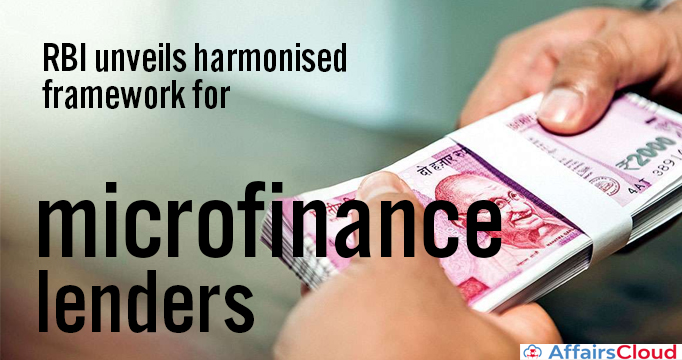
On March 14, 2022, the Reserve Bank of India (RBI) issued ‘RBI (Regulatory Framework for Microfinance Loans) Directions, 2022’ which will be effective from April 01, 2022. These directions are issued by the apex bank by exercising its powers conferred by Section 21, Section 35A and Section 56 of the Banking Regulation (BR) Act, 1949; Chapter IIIB of the RBI Act, 1934; and Sections 30A and Section 32 of the National Housing Bank (NHB) Act, 1987.
- RBI asked the Regulated Entities (REs) to ensure that loans are collateral-free and not linked with a lien on the borrower’s deposit account, repayment obligations are capped, interest rates are not usurious, and there is no pre-payment penalty.
REs under the ambit of Provisions of these Directions:
i.All Commercial Banks (including Small Finance Banks, Local Area Banks, and Regional Rural Banks) excluding Payments Banks
ii.All Primary (Urban) Co-operative Banks/ State Co-operative Banks/ District Central Co-operative Banks
iii.All Non-Banking Financial Companies (including Microfinance Institutions and Housing Finance Companies)
What is Microfinance Loan?
It is defined as a collateral-free loan given to a household having annual household income up to Rs 3,00,000, where household means an individual family unit, i.e., husband, wife and their unmarried children.
Key Provisions under directions:
i.All collateral-free loans, irrespective of end use and mode of application/ processing/ disbursal (either through physical or digital channels), provided to households having annual income up to Rs 3 lakh is to be considered microfinance loans.
ii.Limit on Loan Repayment Obligations of a Household: Each RE should have a board-approved policy regarding the limit on the outflows on account of repayment of monthly loan obligations of a household.
- This is subject to a limit of maximum 50% of the monthly household income.
iii.The margin caps (not exceeding 10% for large MFIs (Microfinance institutions) with loan portfolios exceeding Rs 100 crore and 12% for the others) are no longer applicable to NBFC (Non-Banking Financial Company)-MFIs.
- The maximum limit on microfinance loans for such NBFCs (i.e., NBFCs other than NBFC-MFIs) now stands revised to 25 per cent of the total assets.
- Under the earlier qualifying assets criteria1, a Non-banking Financial Company -Microfinance Institution (NBFC-MFI) is required to have minimum 85 per cent of its net assets2 as ‘qualifying assets’.The minimum requirement of microfinance loans for NBFC-MFIs also stands revised to 75 per cent of the total assets.
iv.Each RE should disclose pricing related information to a prospective borrower in a standardised simplified factsheet, and should prominently display the minimum, maximum and average interest rates charged on microfinance loans in all its offices, in the literature (information booklets/ pamphlets) and details on its website.
v.Cap on loan repayment: The guidelines prescribe a limit on loan repayment obligations of a household. The outflows, capped at 50% of the monthly household income, should include repayments (including both principal as well as interest component).
vi.Each RE has to provide a loan card to the borrower incorporating all relevant information, regarding loan.
vii.Loan recovery: The recovery should be made at a designated/ centrally designated place decided mutually by the borrower and the RE.
- However, field staff can make recovery at the place of residence or work of the borrower if the borrower fails to appear at the designated place.
- The computation of loan repayment obligations shall take into account all outstanding loans (collateral-free microfinance loans as well as any other type of collateralized loans) of the household. The outflows capped at 50 per cent of the monthly household income shall include repayments (including both principal as well as interest component) towards all existing loans as well as the loan under consideration.
Click Here for Official Notification
Recent Related News:
In December 2021, RBI has mandated the companies to quote the 20-digit Legal Entity Identifier (LEI) for cross-border transactions for capital or current account transactions of Rs 50 crore and above, from October 1 2022.
About Reserve Bank of India (RBI):
i.The Reserve Bank of India was established on April 1, 1935, in accordance with the provisions of the Reserve Bank of India Act, 1934.
ii.The Central Office of the Reserve Bank was initially established in Calcutta but was permanently moved to Mumbai in 1937.
iii.Though originally privately owned, since nationalization in 1949, the Reserve Bank is fully owned by the Government of India.